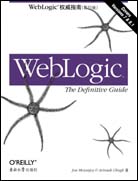
WebLogic权威指南(影印版)
出版时间:2005年06月
页数:852
由于Java编程语言已趋于成熟,许多开发者转而借助Java来满足他们对于企业级应用程序开发的需要。在大多数Java应用程序中,复杂事务管理、消息传递、XML和Web服务支持、命名及目录服务、数据库管理等不仅是其重要的组成部分,而且也是这些应用程序实现自身功能的基础。因此,Java开发人员一直在努力寻求能为企业级应用程序的开发提供上述服务的通用应用服务器,在众多竞争者中,BEA公司的WebLogic服务器处于领先地位。
《WebLogic权威指南》全面介绍了BEA WebLogic。无论你是一名开发人员、管理人员还是系统架构师,阅读此书你会发现,你能更深入地使用WebLogic,更快地进行优化,以及获得更好的性能。本书详细介绍了WebLogic对J2EE领域中标准API的支持以及对核心API的扩展;而对于众所周知的API,比如servlet,JSP以及EJB,本书没有花费过多的篇幅。
本书包含的内容有:
* 运用servlet、JSP以及WebLogic自定义的JSP标记和类库来开发J2EE Web应用程序
* 在WebLogic Web容器中配置和部署应用程序
* 对WebLogic servlet引擎和HTTP服务器的高级管理
* 在WebLogic环境中创建、部署和优化EJB
* 在多服务器环境中安装和管理WebLogic,包括负载均衡、失效转移、会话管理和会话复制的细节
* 设置SSL并使其可为WebLogic应用程序所用
* 应用各种WebLogic安全模式
* 使用WebLogic XML注册文件,Web服务框架,日志功能,以及国际化API
* 利用JMX和SNMP管理WebLogic
《WebLogic权威指南》全面介绍了BEA WebLogic。无论你是一名开发人员、管理人员还是系统架构师,阅读此书你会发现,你能更深入地使用WebLogic,更快地进行优化,以及获得更好的性能。本书详细介绍了WebLogic对J2EE领域中标准API的支持以及对核心API的扩展;而对于众所周知的API,比如servlet,JSP以及EJB,本书没有花费过多的篇幅。
本书包含的内容有:
* 运用servlet、JSP以及WebLogic自定义的JSP标记和类库来开发J2EE Web应用程序
* 在WebLogic Web容器中配置和部署应用程序
* 对WebLogic servlet引擎和HTTP服务器的高级管理
* 在WebLogic环境中创建、部署和优化EJB
* 在多服务器环境中安装和管理WebLogic,包括负载均衡、失效转移、会话管理和会话复制的细节
* 设置SSL并使其可为WebLogic应用程序所用
* 应用各种WebLogic安全模式
* 使用WebLogic XML注册文件,Web服务框架,日志功能,以及国际化API
* 利用JMX和SNMP管理WebLogic
- Preface
- 1. Introduction
- Overview of WebLogic Server
- Software and Versions
- Getting Started with WebLogic Server
- 2. Web Applications
- Packaging and Deployment
- Configuring Web Applications
- Servlets and JSPs
- JSP Tag Libraries
- Session Tracking
- Session Persistence
- Clusters and Replicated Persistence
- Configuring a Simple Web Cluster
- Security Configuration
- Monitoring Web Applications
- 3. Managing the Web Server
- Configuring WebLogic's HTTP Server
- Virtual Hosting
- HTTP Access Logs
- Understanding Proxies
- Web Server Plug-ins
- 4. Using JNDI and RMI
- Using WebLogic's JNDI
- Using JNDI in a Clustered Environment
- Using WebLogic's RMI
- Using WebLogic's RMI over IIOP
- 5. JDBC
- Overview of JDBC Resources
- Configuring JDBC Connectivity
- WebLogic's Wrapper Drivers
- Rowsets
- Clustering and JDBC Connections
- 6. Transactions
- Overview
- EJB Transactions
- The Transaction Service
- Managing WebLogic JTA
- 7. J2EE Connectors
- Assembling and Deploying Resource Adapters
- Configuring Resource Adapters
- WebLogic-Specific Configuration Options
- Using the Resource Adapter
- Monitoring Connections
- 8. JMS
- Configuring JMS Resources
- Optimizing JMS Performance
- Controlling Message Delivery
- JMS Programming Issues
- Clustered JMS
- WebLogic's Messaging Bridge
- Monitoring JMS
- 9. JavaMail
- Configuring a Mail Session
- Using JavaMail
- Using Other JavaMail Providers
- 10. Using EJBs
- Getting Started
- Development Guidelines
- Managing WebLogic's EJB Container
- Configuring Entity Beans
- EJBs and Transactions
- EJBs and Clustering
- 11. Using CMP and EJB QL
- Building CMP Entity Beans
- Features of WebLogic's CMP
- Container-Managed Relationships
- EJB QL
- 12. Packaging and Deployment
- Packaging
- Deployment Tools
- Application Deployment
- WebLogic's Classloading Framework
- Deployment Considerations
- Split Directory Development
- 13. Managing Domains
- Structure of a Domain
- Designing a Domain
- Creating Domains
- Domain Backups
- Handling System Failure
- Domain Network Configuration
- Node Manager
- The Server Life Cycle
- Monitoring a WebLogic Domain
- 14. Clustering
- An Overview of Clustering
- A Closer Look at the Frontend Tier
- Load-Balancing Schemes
- Using J2EE Services on the Object Tier
- Combined-Tier Architecture
- Securing a Clustered Solution
- Machines,Replication Groups,and Failover
- Network Configuration
- Monitoring Clusters
- 15. Performance, Monitoring, and Tuning
- Tuning WebLogic Applications
- Tuning the Application Server
- Tuning the JVM
- 16. SSL
- An Overview of SSL
- Configuring WebLogic's SSL
- Programmatic SSL
- Mapping Certificates to WebLogic Users
- 17. Security
- The Java Security Manager
- Connection Filtering
- The Security Provider Architecture
- The Providers
- Configuring Trust Between Two Domains
- JAAS Authentication in a Client
- Creating a Custom Authentication Provider
- Creating an Identity Assertion Provider
- 18. XML
- JAXP
- Built-in Processors
- The XML Registry
- XML Application Scoping
- WebLogic's Streaming API
- WebLogic's XPath API
- Miscellaneous Extensions
- 19. Web Services
- Using the Web Services Framework
- Web Service Design Considerations
- Implementing the Backend Components
- Datatypes
- Implementing Clients
- Reliable SOAP Messaging
- SOAP Message Handlers
- Security
- UDDI
- Internationalization and Character Sets
- 20. JMX
- The MBean Architecture
- Accessing MBean Servers
- Accessing MBeans
- Examples
- MBean Notifications
- Monitor MBeans
- Timer MBeans
- 21. Logging and Internationalization
- The Logging Architecture
- Listening for Log Messages
- Generating Log Messages
- 22. SNMP
- WebLogic's SNMP Infrastructure
- Using the SNMP Agent
- Traps
- SNMP Proxies
- Index
书名:WebLogic权威指南(影印版)
作者:Jon Mountjoy, Avinash Chugh 著
国内出版社:东南大学出版社
出版时间:2005年06月
页数:852
书号:7-5641-0043-5
原版书出版商:O'Reilly Media
The images on the cover of WebLogic: The Definitive Guide are sand stars. The sand star is a starfish whose main defining feature is the spines that cover the sides of its legs, which differ from the suction cups that most starfish have. The sand star uses these spines to travel. It is chiefly nocturnal and tends to bury itself in sand in daylight hours. Its spines are helpful for allowing it to burrow into and move quickly throughout this sandy environment. The sand star swallows its food whole. Its diet consists of snails, sea urchins, seaweed, other starfish and sand stars, and any dead fish it can find.It often feeds off other creatures it finds buried in the sand alongside it.
购买选项